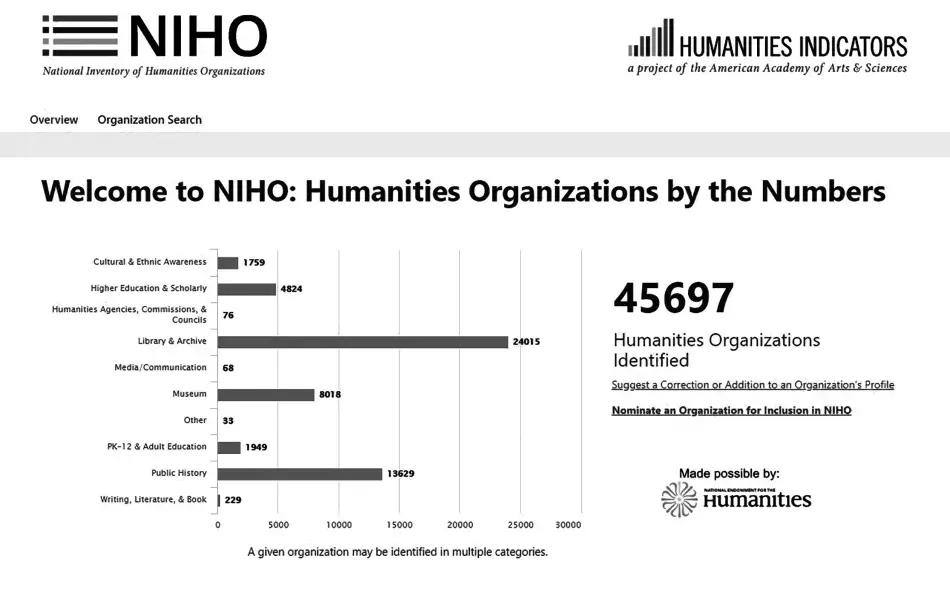NIHO is being updated and expanded to include arts as well as humanities organizations. The National Inventory of Cultural Organizations (NICO) will encompass all not-for-profit humanities and arts organizations reporting information to the IRS via Form 990.
Each organization's entry will include contact information, their revenues, and primary activity type. The inventory will be linked to other data sets that will allow users to identify key characteristics of the communities in which these organizations are found.
The database will be a resource for researchers and advocates, as well as practitioners looking to partner with other organizations to extend and deepen their impact. NICO will debut late 2026. Should you have any questions about the project or wish to receive notification of NICO's release, please contact Robert Townsend at rtownsend@amacad.org.
The Academy recently launched a new informational resource: the National Inventory of Humanities Organizations (NIHO).
Developed with support from the National Endowment for the Humanities and with the assistance of a group advisors from both the academic and public humanities worlds, NIHO identifies and describes close to fifty thousand organizations engaged in a wide range of humanities activities. This information is freely available via an online database (https://www.humanitiesindicators.org/content/niho.htm), which is searchable by organization location, mission, disciplinary focus, and control (e.g., non-profit versus for-profit), among other parameters.
NIHO was developed as a project of the Academy’s Humanities Indicators (HI). Modeled after the National Science Foundation’s Science and Engineering Indicators, the HI’s primary content consists of quantitative measures designed to gauge the health of the humanities enterprise. Among these measures are the number and revenues of not-for-profit organizations engaged in humanities activity. NIHO emerged out of that research, but expanded to include a host of governmental, tribal, and for-profit entities that also do significant humanities work.
NIHO defines a “humanities organization” as including not only institutions that generate humanities scholarship, but also those that translate such scholarship into accessible experiences for the general public (such as museums and historical societies), preserve the heritage of the humanities (such as libraries and archives), and teach key humanities competencies (for example, organizations whose missions include honing young people’s reading and writing skills).
NIHO was developed with a number of different audiences in mind. For humanities practitioners, NIHO will create mutual awareness and foster collaboration. The pooling of expertise and resources will allow organizations to deepen and extend their impact. For policy-makers and the public, NIHO will convey that there is a wide variety of humanities organizations, thereby dispelling the widespread misperception that the humanities are only found at colleges and universities. For funders, NIHO provides a means of identifying and soliciting proposals from smaller, lesser-known groups making important contributions and will allow investigators to draw samples of organizations for closer study.
The pilot phase of NIHO focused on developing the database architecture as well as a humanities organization classification system. With additional resources, the HI hopes to expand NIHO, incorporating additional organizations, particularly those serving PK–12 students.
NIHO will be the focus of an upcoming edition of the HI’s newly redesigned Data Forum, which will feature an essay from Hope Shannon, a former local history organization administrator and scholar, whose research focuses on the genesis and influence of these grassroots organizations, and commentary from Miranda Restovic and Sarah DeBacher of the Louisiana Endowment for the Humanities, whose public programming includes several Head Start centers that deliver a humanities-focused curriculum to preschoolers in traditionally underserved communities. For more details about the Forum, and to receive notification of other HI-related developments, please contact Robert Townsend at rtownsend@amacad.org.

The Humanities in Our Lives
Building on the success of an earlier infographic under the rubric of The Humanities in Our Lives, the Academy’s Humanities Indicators project released in late 2018 a new series (at http://bit.ly/HiOLseries) that couples data about the humanities with profiles of innovative programs in the field.
The new series on The Humanities in Our Lives, developed with funding support from The Andrew W. Mellon Foundation, takes an expansive view of the humanities, with topics ranging from early childhood reading programs to later in life visits to historic sites. This extensive focus reflects the Indicators’ holistic view of the humanities and demonstrates the wide range of subject areas across which Indicators data can be brought to bear.
Topics covered include:
- America’s Native Languages
- Community Colleges
- Degrees in the Humanities
- Digital Humanities
- Elementary School Readers
- Historic Sites in the United States
- History in the Schools
- Humanities and Medicine
- Humanities Jobs
- Humanities Tourism
- Language Learning
- Learning a Second Language
- Libraries as a Community Anchor
- Multilingualism in Public Service
- Multilingualism in the Workforce
- Museum Attendance
- Poetry
- Public Libraries
- Reading for Pleasure
- Reading to Young Children
- The Value of Languages
- U.S. Higher Ed Ethics Bowls
- Writing Skills
The Indicators staff welcomes thoughts and suggestions for future topics and programs in the series; please contact Robert Townsend, Director of the Humanities Indicators, at rtownsend@amacad.org.